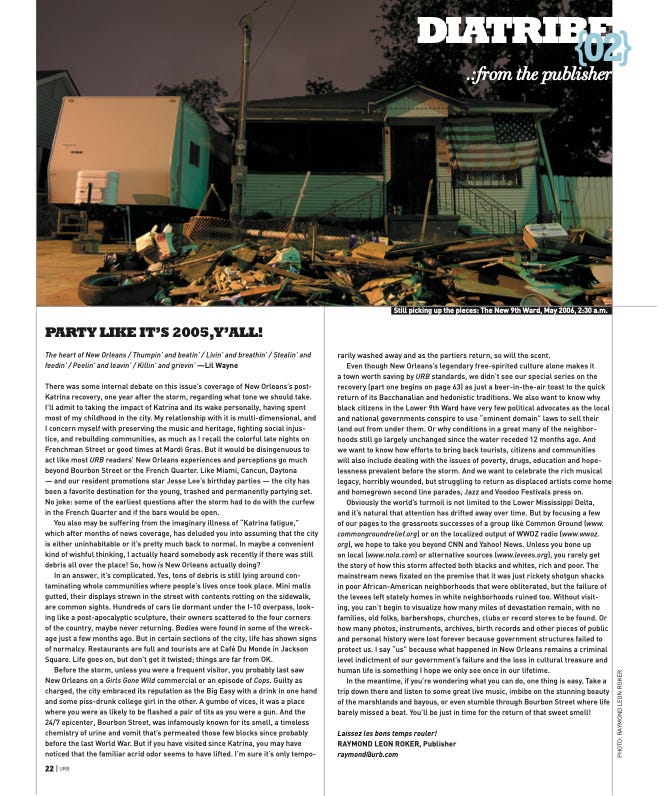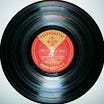Originally Published in Issue 139, September 2006
The heart of New Orleans / Thumpin’ and beatin’ / Livin’ and breathin’ / Stealin’ and feedin’ / Peelin’ and leavin’ / Killin’ and grievin’
—Lil Wayne

There was some internal debate on this issue’s coverage of New Orleans’s post-Katrina recovery, one year after the storm, regarding what tone we should take. I’ll admit to taking the impact of Katrina and its wake personally, having spent most of my childhood in the city. My relationship with it is multi-dimensional. I’m concerned with preserving the music and heritage, fighting for social justice, and rebuilding communities as much as I am for colorful late nights on Frenchman Street or the good times at Mardi Gras. But it would be disingenuous to act as most URB readers’ New Orleans experiences and perceptions go much beyond Bourbon Street or the French Quarter. Like Miami, Cancun, Daytona—and our resident promotions star Jesse Lee’s birthday parties—the city has been a favorite destination for the young, trashed, and permanently partying set. No joke: some of the earliest questions after the storm concerned the curfew in the French Quarter and if the bars would be open.
You also may be suffering from the imaginary illness of “Katrina fatigue,” which has deluded you after months of news coverage to assume that the city is either uninhabitable or pretty much back to normal. In maybe a convenient kind of wishful thinking, I heard somebody ask recently if debris was still everywhere! So, how is New Orleans doing?

“My relationship with [New Orleans] is multi-dimensional. I’m concerned with preserving the music and heritage, fighting for social justice, and rebuilding communities as much as I am for colorful late nights on Frenchman Street.”
Yes, tons of debris are still lying around, contaminating communities where people’s lives once took place. Mini malls gutted, their displays strewn in the street with contents rotting on the sidewalk, are familiar sights. Hundreds of cars lie dormant under the I-10 overpass, looking like a post-apocalyptic sculpture, their owners scattered to the four corners of the country, maybe never returning. Bodies were found in some of the wreckage just a few months ago. But in certain city sections, life has shown signs of normalcy. Restaurants are bustling, and tourists are at Café Du Monde in Jackson Square. Life goes on, but don’t get it twisted; things are far from OK.
Before the storm, unless you were a frequent visitor, you probably last saw New Orleans on a Girls Gone Wild commercial or an episode of Cops. Guilty as charged, the city embraced its reputation as the Big Easy with a drink in one hand and some piss-drunk college girl in the other. A gumbo of vices, it was a place where you were as likely to be flashed a pair of tits as a gun. And the 24/7 epicenter, Bourbon Street, was infamously known for its smell, a timeless chemistry of urine and vomit that’s permeated those few blocks since probably before the last World War. But if you have visited since Katrina, you may have noticed that the familiar acrid odor seems to have lifted. I’m sure it’s only temporarily washed away, and as the partiers return, so will the scent.
Even though New Orleans’s legendary free-spirited culture makes it a town worth saving by URB standards, we didn’t see our special series on the recovery (part one begins on page 63) as just a beer-in-the-air toast to the quick return of its Bacchanalian and hedonistic traditions. We also want to know why black citizens in the Lower 9th Ward have very few political advocates as the local and national governments conspire to use “eminent domain” laws to sell their land out from under them. Or why conditions in a great many of the neighborhoods still go primarily unchanged since the water receded 12 months ago. And we want to know how efforts to bring back tourists, citizens, and communities will also include dealing with the issues of poverty, drugs, education, and hopelessness prevalent before the storm. And we want to celebrate the rich musical legacy, horribly wounded but struggling to return as displaced artists come home and homegrown second-line parades, Jazz, and Voodoo Festivals press on


The world’s turmoil is not limited to the Lower Mississippi Delta; naturally, attention has drifted away. But by focusing a few of our pages on the grassroots successes of a group like Common Ground (www. commongroundrelief.org) or on the localized output of WWOZ radio (www.wwoz. org), we hope to take you beyond CNN and Yahoo! News. Unless you bone up on local (www.nola.com) or alternative sources (www.levees.org), you rarely get how this storm affected both Blacks and whites, rich and poor. The mainstream news fixated on the premise that it was just rickety shotgun shacks in poor African-American neighborhoods that were obliterated. Still, the failure of the levees left stately homes in white neighborhoods ruined too. Without visiting, you can’t begin to visualize how many miles of devastation remains, with no families, old folks, barbershops, churches, clubs, or record stores to be found. Or how many photos, instruments, archives, birth records, and other public and personal history were lost forever because government structures failed to protect us. I say “us” because what happened in New Orleans remains a criminal-level indictment of our government’s failure and the loss of cultural treasure and human life, which I hope we only see once in our lifetime.
In the meantime, if you’re wondering what you can do, one thing is easy. Take a trip down there and listen to some great live music, imbibe on the stunning beauty of the marshlands and bayous, or even stumble through Bourbon Street, where life barely misses a beat. You’ll be just in time for the return of that sweet smell!
Laissez les bons temps rouler!




